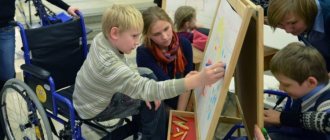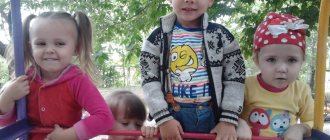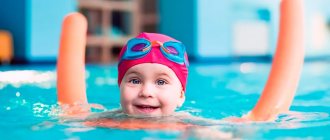Plan of individual correctional and developmental classes for a teacher-defectologist
Logical connections and relationships:
installs with errors (it is difficult to find an extra item).
Mathematical representations
Check:
within 5, sums up after the prompt, does not count backwards.
Correlation between number and quantity:
correlates within 5.
Correlation of figure, number and quantity:
correlates within 5.
Computing skills:
with mistakes.
Calculates:
based on a specific material.
Performs tasks:
both independently and with the help of an adult.
Solving arithmetic problems:
solves within 3.
Learning ability
Help:
needs stimulating help when having difficulty completing a task.
Nature of assistance:
Stimulating and guiding assistance and step-by-step adult supervision are required.
Scope of assistance:
average
Transferability to similar assignments:
the transfer is carried out, but additional time is required to assimilate and consolidate the demonstrated method of action.
Defectological conclusion:
Specific difficulties in developing study skills.
The level of learning is average.
Cognitive activity is at an average level.
Planned events:
Classes with a speech pathologist teacher individually and in a subgroup with a frequency of three lessons on the formation of elementary mathematical concepts and two on familiarization with the outside world per week.
The content of the work .
I
(October 2022 – December 2020)
1. Familiarization with the outside world
- continue to introduce objects of the immediate environment: toys, clothes, shoes, etc.;
- learn to correctly use sensory standards in speech, compare familiar objects;
- consolidate ideas about oneself, one’s family, family members, learn to determine the degree of kinship.
- continue to introduce the kindergarten, the work of adults, its contents: teacher, salesperson, cook, nurse, etc.;
-expand ideas about holidays: New Year, winter entertainment.
- expand ideas about the seasons and natural phenomena;
- introduce the names of the parts of the day;
- learn to determine the state of the weather, changes in nature, describe them, establish the simplest connections between natural phenomena;
-expand ideas about the plant world: vegetables, fruits, trees, mushrooms, berries;
-continue to introduce the animal world: wild animals, their young, domestic animals, their young, poultry, note their characteristic features, expand ideas about the characteristics of behavior, movement, and the benefits they bring to people;
— introduce people to the work of caring for pets;
- learn to differentiate general concepts.
- learn to compose a story of 3-4 sentences about the subject, the content of the plot picture according to the reference diagram.
“Forms, methods, technologies of working with preschool children in accordance with the Federal State Educational Standard for Education”
The world of childhood is unique and inimitable; childhood impressions, good and bad, remain in people’s memory forever. Scientists have long discovered that the decisive factor in the development of certain characteristics of thinking is not the experience itself (knowledge, abilities, skills), but the methods of its assimilation. Creative activity is a reliable assistant in raising and teaching children.
Our OOD is structured in such a way that one type of activity is replaced by another. This allows us to make the children’s work less tiring and intense. Game forms allow you to activate the cognitive interests of preschoolers, surprise, and ignite the flame of curiosity. In play activities, children intensively develop their powers of observation, memory, and imagination.
People have been using games as a learning method for a long time. Gaming activities can be used in the following cases: a) as independent technologies for mastering a topic or section; b) as elements of a broader technology; c) as a lesson or part of it (explanation, reinforcement).
Communication games involve working in pairs, groups of large and small, and as a whole group, while participants must be able to move freely around the room. For such games, a subject-spatial environment or child development centers are created, with rich mobile, replaceable material.
The pedagogical process should not impose a template approach to solving tasks; it should respect and develop the uniqueness of the individual style of each preschooler.
The educational games that I use in my classes are based on the principle of organizing classes in small groups. This makes it possible to include all children in active work, organize competition between teams, and develop the ability to work in a team. Game situations help create a positive attitude towards learning and development, which is a necessary prerequisite for successful learning of the material. Education is based on the following types of activities: cognitive, playful, creative, communicative. As a result, preschoolers will have sufficiently developed
moral standards of behavior, culture of communication in a team, ability to cooperate. When using games in my work, I take into account that they must have two principles: educational and cognitive and entertaining. Of the wide range of methods and techniques for working with children, those play activities that allow them to comprehensively solve developmental, educational and educational tasks are primarily used.
I also use the project method in my work. The essence of this method is to stimulate children’s interest in certain problems that require mastery of a body of knowledge, and through project activities to show the practical application of the acquired knowledge. If we talk about the project method as a pedagogical technology, then it involves a combination of research, search, and creative methods. Preschool age is fertile ground for the education, upbringing and development of a child - this period in the life of children is characterized by sustained attention, observation, and a surge of cognitive interest. That is why the most effective method in teaching children is the project method. This method develops interest in various areas of knowledge, develops skills in collective and independent work, activity, and helps connect learning with life. Project activities make it possible to unite a teacher - a senior friend and mentor, children, parents and other teachers - into one team.
Individual lesson on FEMP in the senior group
Lexical topic.
"Winter". FEMP (shape, size, prepositions)
Target.
Teach children to find objects of a given shape and size; consolidate the concepts of “under”, “above”, “next to”, “towards each other”.
Demonstration material.
A picture showing 2 lumps (large and small), 2 pairs of skis and poles (long and short), 2 snowmen (high and low; the tall snowman has a wide scarf, the short snowman has a narrow one).
Handout.
Geometric shapes (2 large and 1 small: circle, triangle, square, rectangle, oval).
Age: 5-6 years
Progress of the lesson
Organizing time
Game “Name the object: big - small, long - short, wide - narrow.”
Children name objects based on the demonstration picture, which depicts 2 lumps (large and small), 2 pairs of skis and poles (long and short), 2 snowmen (high and low; the tall snowman has a wide scarf, the short snowman has a narrow one).
Main part
Defectologist. Are the snowmen the same size? (No, they are different sizes.)
- How can this be checked?
- Find high and low objects in our environment.
Working with handouts
Each child has geometric shapes: 2 large and 1 small (circle, triangle, square, rectangle, oval).
Defectologist. On what basis can these figures be grouped? (According to form.)
Children group shapes.
— How many groups did you get? (Five.)
- Name the figures in the first (second... fifth) groups.
- Mix all the figures.
- On what other basis can these figures be divided into three groups? (To size.)
— What are the shapes of the figures in each group? (Each group contains one circle, triangle, square, rectangle, oval.)
- Compare the size of three triangles (circle, square, rectangle, oval).
- What size are these three figures? (Two large triangles and one small.)
- How to check this? (Apply.)
— Show two large triangles.
-What size are they?
— What can you say about the size of such figures? (They are the same size.)
Physical education minute
Imitation of movements: playing snowballs (large - small), rolling balls for a snowman.
Game "Under, Over, Next"
- What can stand (lie) under the bed (table, chair, closet)?
— What can hang above the bed (table, chair, wardrobe)?
— What can hang (lie) next to the bed (chest of drawers, drawers, bedside tables, tables)?
Game "Towards each other"
Two children stand facing each other at opposite ends of the group room. The speech pathologist invites them to slowly approach each other. Children meet each other halfway. Then the teacher invites them to turn their backs to each other and go in different directions.
Defectologist. Are Kolya and Vasya going towards each other? (No, not towards.)
Learning the phrase “toward each other.”
Lesson summary
Generalizing questions on the topic of the lesson.




